Discover the simplicity and eco-friendly design of vault toilets, the go-to solution for sanitation in areas without access to plumbing.
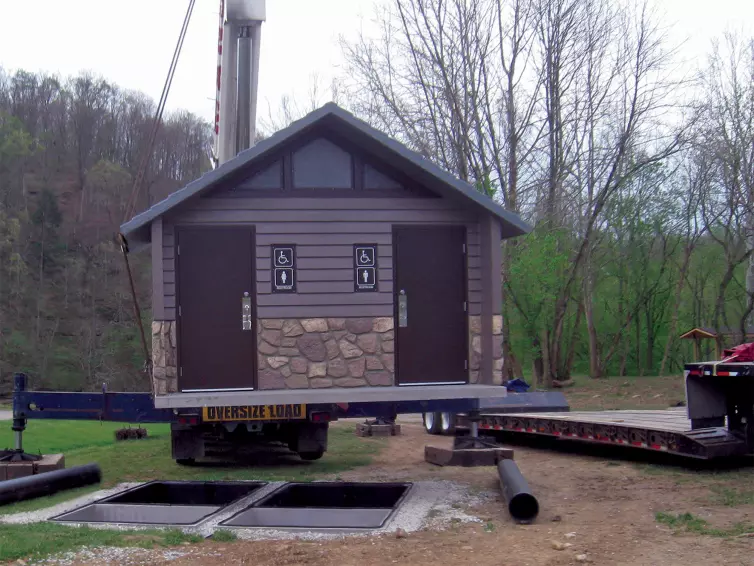 Cascadian double vault toilet installation.
Cascadian double vault toilet installation.
Vault toilets are environmentally friendly and efficient for remote areas, featuring a sealed underground ‘vault’ system, easy installation, and odor-reducing ventilation, without the need for water or sewage systems.
These facilities offer flexible designs and customization options to accommodate different environments and usage volumes, with versions such as single- or double-occupancy available for diverse site requirements.
Maintenance of vault toilets involves routine emptying when reaching capacity, with the frequency depending on usage and climate, as well as odor management through effective ventilation and regular cleaning protocols.
 The 'Cascadian' a single vault toilet.
The 'Cascadian' a single vault toilet.
This sealed, underground tank system, known as the vault toilet, is essential for preserving the environment in off-grid locations while offering hassle-free installation and low maintenance. Explore the benefits, installation process, and maintenance of these sustainable vault toilets through our comprehensive guide.
Vault toilets are a game-changer in the realm of sanitation, particularly in remote areas. These toilets operate by depositing waste into a sealed underground container, or ‘vault,’ without the need for input or output pipes or water flow. Thanks to this design, vault toilets offer the following benefits:
They maintain an odor-free environment by exhausting gases through a vent pipe.
They are easy to install and maintain.
They are cost-effective and environmentally friendly.
They can be used in areas without access to water or sewage systems.
These toilets, typically constructed of robust precast concrete, are designed to withstand long-term use in varied environments. What sets them apart from conventional pit toilets?
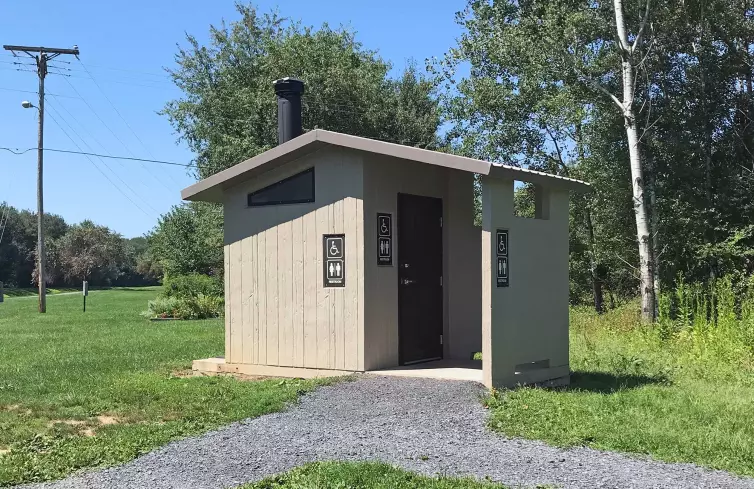 Gunnison, Single Vault Toilet, Waterless Restroom by CXT
Gunnison, Single Vault Toilet, Waterless Restroom by CXT
A vault toilet’s design is quite simple yet effective. Its key components are:
A large sealed underground container, known as a ‘vault’
A riser, a bench with an opening equipped with a toilet seat, which serves as the user interface
A ventilation system that exhausts gases from the vault into the atmosphere, managing odors
These robust structures, typically constructed using precast concrete, can withstand harsh environmental conditions for long-term durability.
So, unlike pit toilets, in what ways does this setup contrast with the old pit toilets we frequently encounter?
The main difference between vault and pit toilets lies in their waste management. Vault toilets isolate waste in a concrete tank, significantly reducing the risk of contaminating the surrounding soil and groundwater. This is a marked improvement over pit toilets, where waste is deposited into an unlined hole.
Moreover, the ventilation system in vault toilets enhances air circulation, reducing odors more effectively than the basic ventilation in a pit toilet. Consequently, with their enclosed waste management system and improved odor control, vault toilets offer a more controlled and environmentally sustainable solution over traditional pit toilets.
Vault toilets stand out as the ideal choice for remote locations. Not only are they resilient to floods, snow, wind, and seismic activities, but they also pose minimal environmental impact as they are waterless and prevent ground contamination. They can be installed quickly, often within a single day, offering an immediate sanitation solution.
Additionally, these toilets meet ADA compliance, providing accessibility and ease of use for people with diverse mobility requirements.
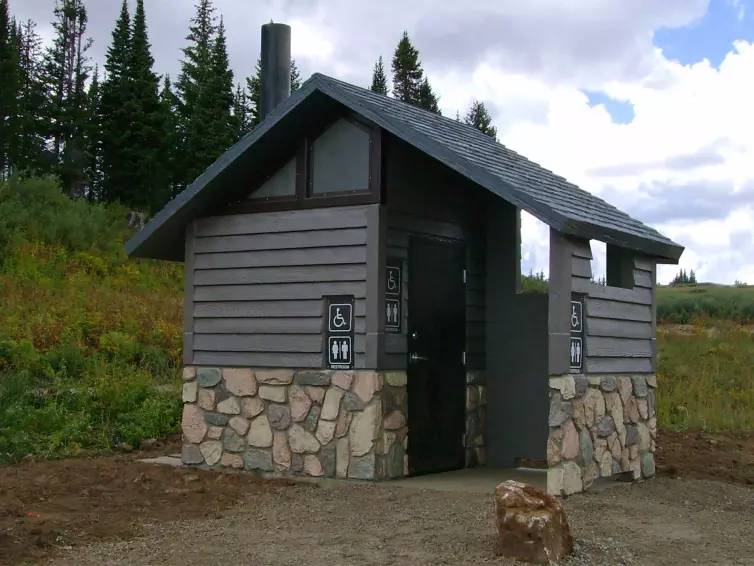 Rocky Mountain, Single-User Vault Toilet, Waterless Restroom by CXT
Rocky Mountain, Single-User Vault Toilet, Waterless Restroom by CXT
The durability of vault toilets makes them cost-effective. Constructed using resilient precast concrete, these toilets can withstand harsh environments, reducing the need for frequent repairs or replacements.
The servicing schedule for vault toilets, including waste vault emptying, fluctuates depending on user count and regional weather conditions. Interestingly, chillier climates may decrease the servicing frequency due to diminished odor.
One of the standout environmental benefits of vault toilets is water conservation. By eliminating the need for flushing, these toilets save water and avoid the need for sewage infrastructure. They also prevent waste contamination of the soil and water table, making them suitable for ecologically sensitive areas.
Vault toilets also boast a significant waste storage capacity, as the vault holds up to 1,000 gallons before necessitating emptying, thereby advocating for responsible waste management.
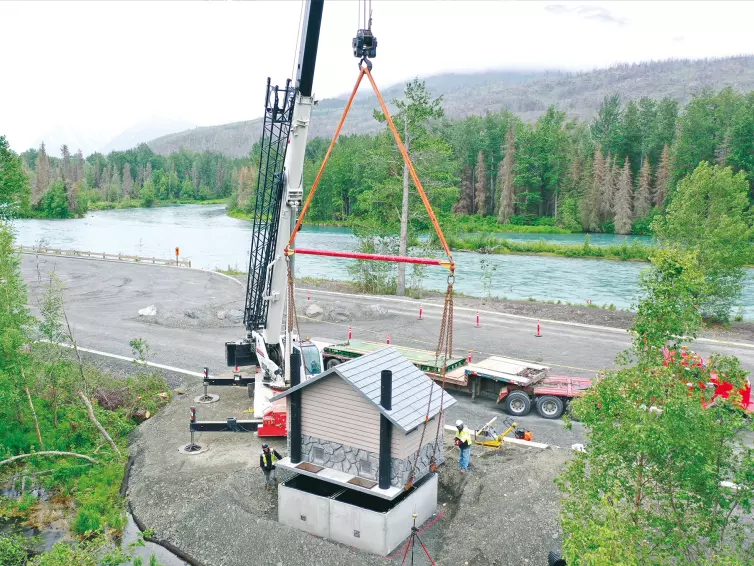 Double vault toilet being lowered by crane onto concrete vault.
Double vault toilet being lowered by crane onto concrete vault.
Far from a one-size-fits-all solution, most vault toilets are available in a range of options to cater to diverse user volumes and environments. From single-occupancy configurations to dual-occupancy models like Model 1005 and Model 1011, they cater to different user volumes and settings such as recreational parks or remote camping sites.
Also, they offer a range of customization options, including a variety of stone, wall, and roof choices, to complement natural surroundings.
Whether you are looking for a basic single-unit model or an advanced design with multiple stalls, vault toilets cater to different levels of user traffic. For instance, double vault toilets, equipped with two waste tanks, are designed to handle the higher waste volumes that come with increased usage in busy locations.
Advanced models can also be customized in floor plans, colors, and textures to meet the specific needs of a location.
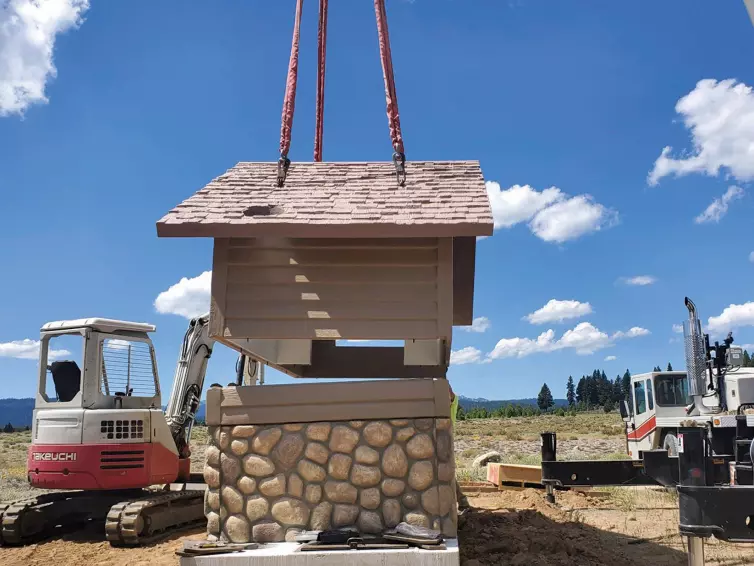 Rocky Mountain - Single Vault Toilet - lowered into position by crane.
Rocky Mountain - Single Vault Toilet - lowered into position by crane.
Vault toilets can be finely tuned to blend with a variety of environmental settings. Thanks to the broad range of customization options, these toilets can be visually unobtrusive. Whether you prefer a selection of colors and finishes that blend with the natural or built landscape, or a flexible layout based on the specific needs of your location, vault toilets offer the adaptability you need.
Installing a vault toilet involves several steps, including site preparation and sealing. The location should have enough space for a 20-foot radius clear zone around the toilet to facilitate proper airflow. Selective pruning of trees within the vicinity of the toilet is recommended to maintain this zone.
Despite these requirements, vault toilets can be quickly installed with minimal preparation, becoming operational on the same day they are installed.
The installation of a vault toilet begins with an excavation of specific dimensions to accommodate the foundation and vault size. The foundation must be designed to support units that can range from 500 to 1,500 gallons in capacity. Following this, a prefabricated building is placed on a concrete slab over the vault, which is typically installed five feet deep.
To prevent water from seeping into the vault, the ground around the service manhole should be elevated, and vent openings should be covered with screens to prevent animal entry and facilitate odor control.
Proper ventilation and sealing play a crucial role in the functionality of vault toilets. The ventilation system naturally circulates air through the building, channeling it out of the vault and vent pipe to effectively reduce odors. In environments with limited airflow, like dense forests, installing a fan to assist with ventilation may be necessary to ensure proper air circulation.
To manage odors, a synergistic approach involving well-designed ventilation systems, harmless chemical treatments, and regular maintenance is vital.
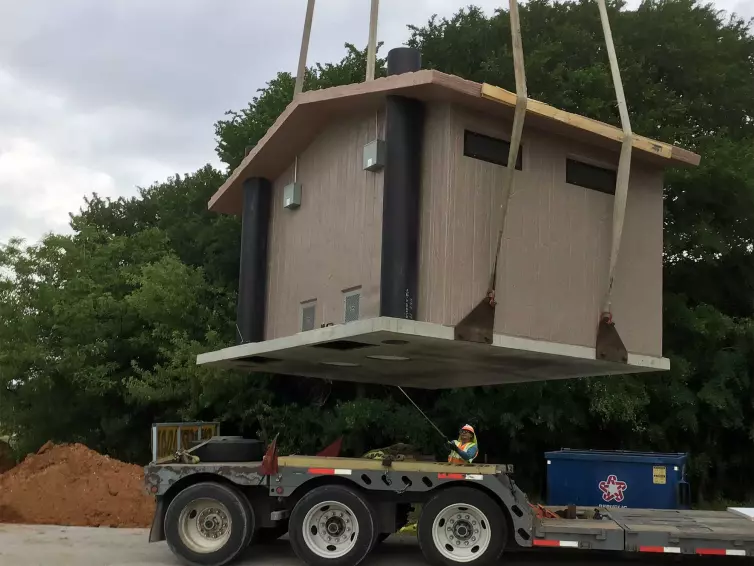
Vault toilets require routine emptying to remain clean and functional, and the frequency of this servicing hinges on their usage and capacity. Maintaining sanitation in vault toilets involves proper usage, prompt waste containment, and providing facilities for handwashing with sanitizers or soap.
In contrast to composting toilets that necessitate regular upkeep, vault toilets typically need only periodic pumping.
Vault toilets feature large capacity tanks, which range from 500 to 1,500 gallons, thereby reducing the frequency of waste pumping needed. However, emptying of vault toilets is typically required once the holding tank reaches approximately 1,000 gallons of waste or 15,000 uses. In areas with high visitor traffic, vault toilets may require emptying on a weekly basis to prevent overfilling and control odors.
The cleaning protocol for vault toilets includes waste removal, replenishing odor-neutralizing solutions, and restocking essential supplies such as toilet paper.
Controlling odors is a key aspect of vault toilet maintenance. However, in colder climates, odors from vault toilets can become more pronounced, indicating additional measures for odor control may be necessary.
Although vault toilets bring a plethora of advantages, it’s worth considering innovative alternatives like composting toilets and portable vault toilets.
Composting toilets offer an eco-friendly alternative to traditional vault toilets. These innovative systems use natural processes to break down human waste without water. The byproduct is a nutrient-rich fertilizer that enhances soil fertility. They require minimal maintenance and can be installed in spaces with limited area.
While prefabricated units average around $1,500, composting toilets can also be built using lumber, offering a cost-effective solution.
Portable vault toilets are ideal for temporary events or construction sites. These sealed container toilets offer easy setup and maintenance, reducing the complexity of managing sanitation facilities in temporary settings. One of their key advantages is the flexibility to be easily relocated as required by the dynamics of the site or event.
In conclusion, vault toilets offer a reliable, cost-effective, and eco-friendly sanitation solution, particularly for remote locations. They come in different models and can be customized to blend with the surroundings. While they require regular maintenance, the frequency is far less than that of composting toilets. Innovative alternatives such as composting toilets and portable vault toilets also offer unique benefits. Ultimately, the choice depends on the specific needs of the location and users.
A vault toilet is a type of toilet that operates by depositing waste into a sealed underground container or 'vault,' without the need for input or output pipes or water flow.
A vault toilet differs from a pit toilet by storing waste in a concrete tank and including a ventilation system for better odor control and reduced groundwater contamination. Consider these factors when choosing a toilet system.
Installing vault toilets in remote locations provides quick installation, cost-effectiveness, low maintenance, and environmental benefits such as water conservation and ground contamination prevention. Overall, vault toilets are a practical and sustainable solution for remote areas.
To maintain a vault toilet, it's essential to regularly empty it based on usage and capacity, while also ensuring proper usage, waste containment, and handwashing facilities for sanitation.